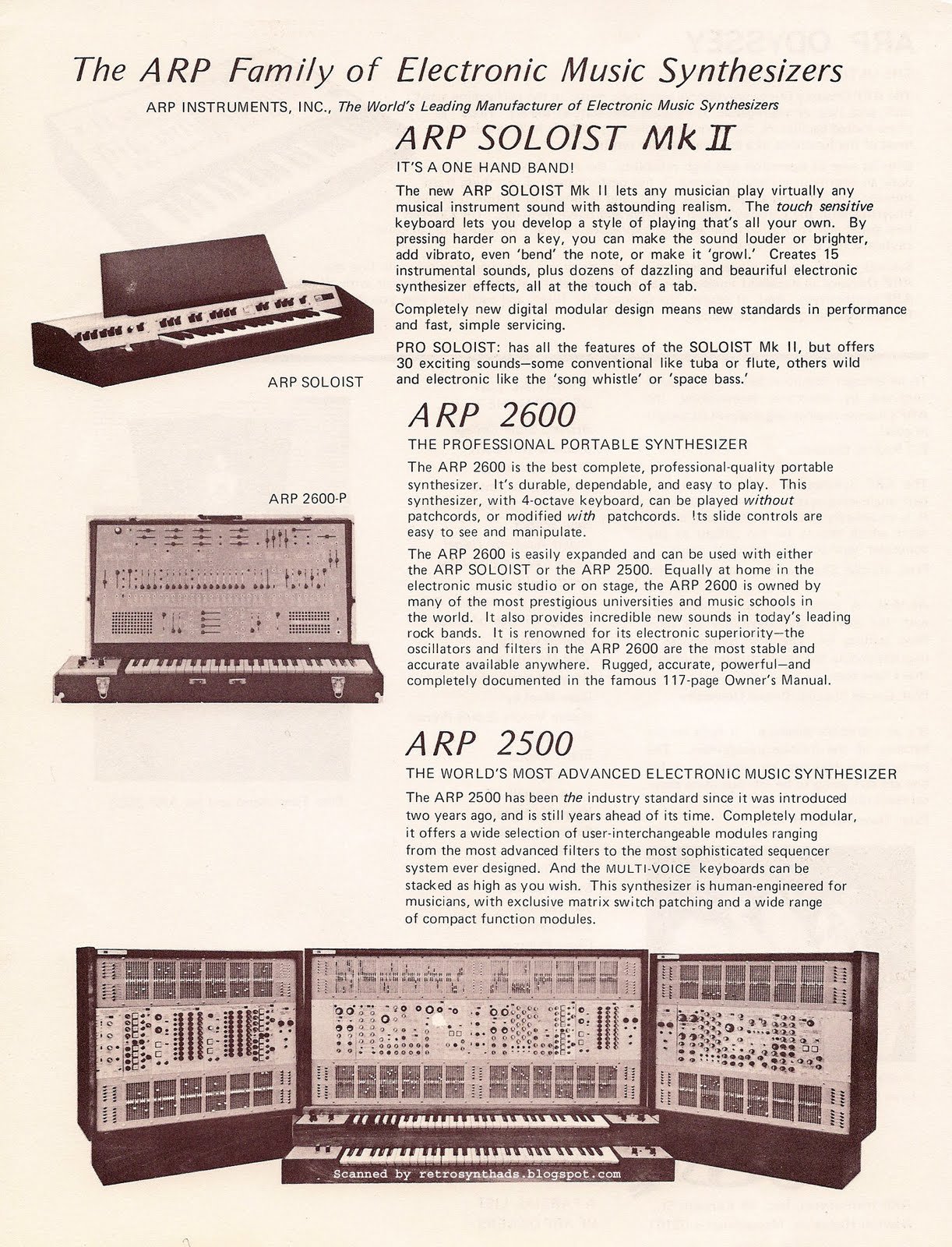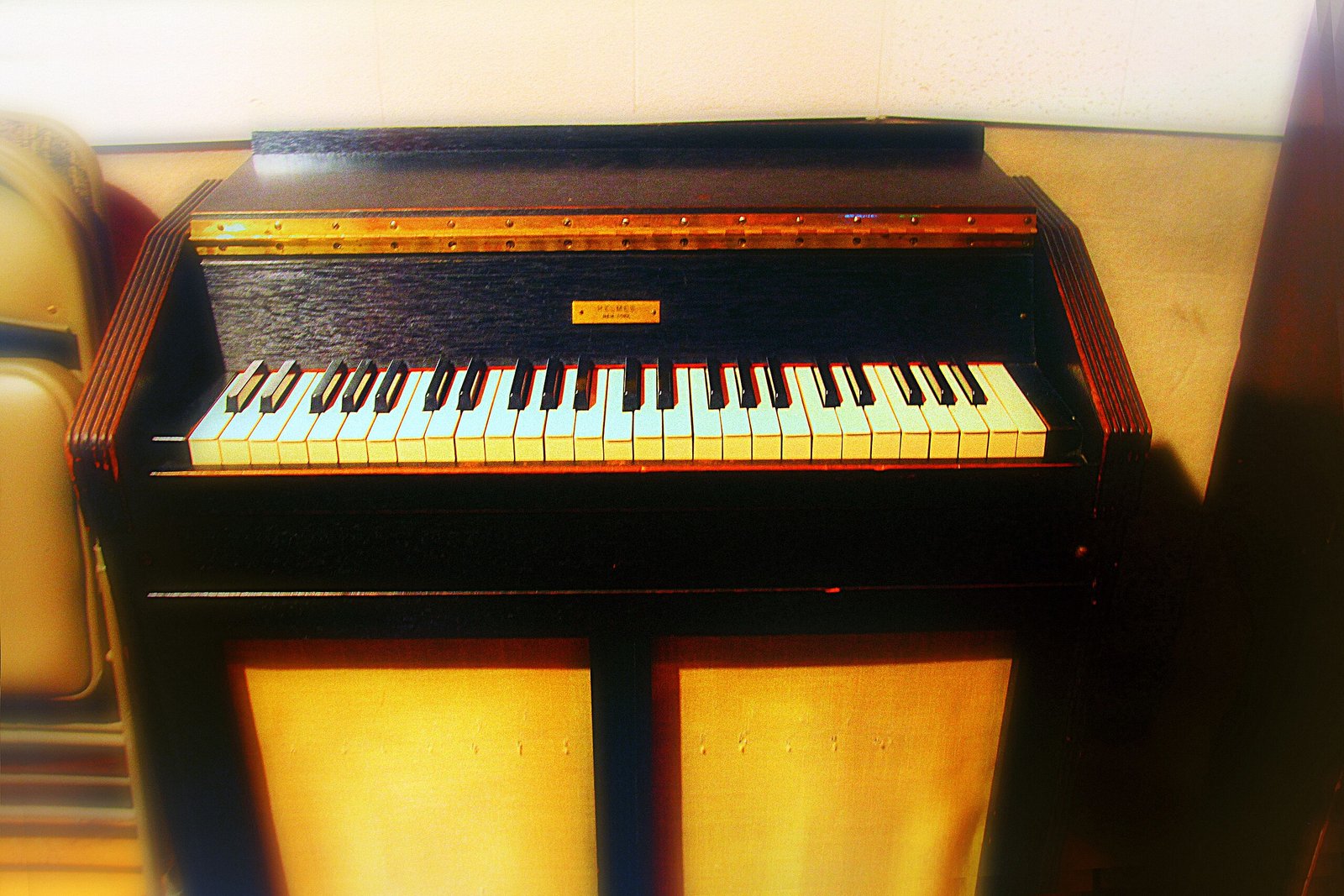Image Credit: Helmes Celesta, RCA Studio B by Adinda Uneputty, licensed under the Creative Commons Attribution-Share Alike 2.0 Generic license.
Lately, I’ve been haunting Synthchaser’s Tube of Yous Channel because I’ve been thinking a lot about ARP’s early synths. Not the normal ones that everyone thinks of like the 2600 or the Odyssey – I’ve been obsessed with the ‘preset’ ones like the Pro Soloist, Pro/DGX, and even the Explorer 1. They were quite powerful for their time, with the ‘Soloist’ models incorporating a rudimentary ‘aftertouch’ system for adding expression to the basic sounds – something we wouldn’t incorporated across the board until over a decade later. If you want an expansive history of ARP, you need to check out Alex Ball’s documentary, and the Alan R Pearlman Foundation has a lot of info on their site as well.
The original ARP ‘preset’ synth was called the Soloist, and (to the best I can find) was officially released in 1970. There was a ‘Mk II’ model (see pic below) that was released about a year later and was retooled to resemble the Pro Soloist that debuted in 1972, which added more sound presets and an improved ‘aftertouch’ response to the existing Soloist design. The Pro/DGX was an updated version of the Pro Soloist that was in production from 1977-1981. The Explorer 1 was not so much a ‘preset’ model as more of an ‘entry-level’ version of the 2600 or Odyssey, with a lone oscillator (the same used in the 2600) and the filter from the Pro-Soloist as an affordable starting point for synthesists, and probably to stem some competition coming from Moog’s Satellite and the incoming wave of Japanese manufacturers.
The research above came about from listening to a lot of Johnny Costa’s work with Mr. Roger’s Neighborhood, both when I was a young lad, and mostly once I had kids and started watching a lot of the videos with them all over again. Besides being an immensely talented Jazz Pianist, Costa also used a celeste (similar to the one in the Post Pic above), the occasional accordion, and an ARP Soloist synthesizer into the music woven throughout Fred Roger’s television shows. I find his use of synthesizer beautifully captivating and wistfully charming the way he incorporates them into the programs. For the curious, there is even an episode of Fred Rogers demonstrating it in 1980.
This is the intro to our little Mystery.
As we read above, the ARP Soloist was released in 1970, but ARP Instruments itself didn’t even start until 1969 with the release of their first synth, the 2500, the following year (incidentally the same year the Soloist was released). So far so good, right? The ARP 2600 (according to VintageSynth and Wikipedia) was released in 1971, and if you notice the numbering scheme this makes perfect sense. However, the Soloist was also known as the Model 2700. Why would 2700 come before 2600?
In production terms, this could make sense. Develop the ‘big synth’ first for pros and educational purposes while also working on other versions for the remainder of the market. The same technology would go into making these ‘portable’ versions, and it would be conceivable that the Soloist was easier to piece together and manufacture over its bigger sibling, the 2600. This could also explain why it was released as the ‘Soloist’ and not the ‘2700’ – to eliminate any confusion in the numbering scheme. There is not a lot of info Online about the Soloist, so I am just speculating here.

The ARP Soloist Spec Sheet. Image from the delightful RetroSynthAds.

ARP Spec Sheet showing the mysterious Soloist Mk II, 2600-P, and 2500. The 2600-P dates to late 1971, giving an idea of when this was released. Image also from RetroSynthAds.
However, this is not the crux of our little mystery. The thing I started wondering about is that I know I’ve heard electronic sounds used in Mr. Roger’s Neighborhood episodes since some of the earliest ones (there is an episode in ‘season one’ (1968) in which Bruce Haack shows off his electronic music-making gadgetry, but this is before Costa began incorporating electronic sounds into the show). Once I started looking into the ‘Second Season’ 1969 episodes I found what I knew I had heard.
Being a certified synth geek, I had to find out what it was Costa was using during that time. Once I found out it was an ARP Soloist from some research and pictures (there are also some later pics that show what looks to me like a Yamaha DX-series synth covered with stickers for the preset selections), I started digging into what the ARP could do, and how it sounded. It was when I went back and watched those old episodes from 1969 that I was astonished to find that to my ears those sounds are incredibly similar to the ‘preset’ sounds in the Soloist – which according to what the Interwebz® should not have existed at the time these shows were made…
As I’ve said, I’ve watched a lot of Mr. Rogers with my two kids – especially my youngest. And thanks to generosity of the Fred Rogers Foundation, you can watch 10 episodes a month online for free (half early and half later shows). There are also DVD’s available with selected episodes, and you can buy or rent others from the usual Online Suspects.
I would like to give you a specific link to this episode, but The Fred Rogers Foundation is very picky about where Mr. Roger’s Neighborhood is aired and distributed (understandable). I can, however, point you to this link of the specific show ending that has piano, celeste, and synthesizer in it. The electronic melodies are very ‘Johnny Costa-like’ and similar to what is heard in the show I am talking about – the first episode I can find that has ‘electronic music’ used in the soundtrack. There is some info in the comments that it was rebroadcast in 1971, but whether additional music was added for this rebroadcast I cannot verify. There is the possibility that this end ‘bumper’ was using pre-recorded music from a different time or recording session, but please trust me – there is some synthesizer or electronic instrument making sounds within this episode as well as those that occur in the same 1969 ‘season’ forward.
The show itself (Episode 1008) has very distinct synth melodies (along with piano and celeste) in the ‘making paint’ film shown early in the program (it starts at around the 2:47 mark). The Air Date according to the Neighborhood Archive is February 19, 1969. When the program was recorded is not mentioned, but it would certainly be before this date. A web search for this episode might help you find what I am talking about if you want to do the research yourself, but there are no guarantees of finding it – like everything else on the Interwebz®.
It’s at this point that I’m thinking how on earth is there ‘synthesizer music’ in a show that pre-dates the synthesizer (well, at least one of them) that Johnny used? We are dealing with things over 50 years back, so there will be little other than the record of the shows themselves, documentation in pictures or scans, and any interviews that might still be available on the Web. Let the research begin…
Both Fred Rogers and Johnny Costa are long since gone. Johnny Costa’s website is also gone. I tried using the Wayback Machine, but there was nothing substantive to be found here – lots of broken links and pictures that were missing. So other than the few places left I have linked to in this post, what’s left is inference and gut instinct. This will get messy, so let’s go over several possible explanations here before we get into ‘yarn-covered cork board‘ parts:
- Johnny Costa could very well have used a Clavioline or Hammond Solovox for these sounds. Both were available decades before the show aired and were likely available at the time, and being older technology were probably very cheap as well. It is also possible that’s it’s one of the many electronic organs that were produced in the 1960’s. However, in a 1985 interview in Keyboard magazine, Costa talks about the ARP and how he initially resisted it because ‘…I could achieve that without using an electronic organ. I never wanted to get into electronics…‘ This tells me that until he heard the Soloist he had no interest in such things. Bonus pic from that article: he’s still rocking the Soloist in 1985.
- They could have been re-recorded (or dubbed over) at a later date after he acquired the ARP. Although feasible, I find this unlikely since the music was always recorded live for each and every episode, and the time needed to do this after the fact seems very tedious for such a heavy production schedule the show went through through 1975. Maybe Johnny and Fred decided to add elements to the program after that, but it doesn’t seem like something they would do. Fred Rogers was very forward-thinking in archiving his shows for future viewing, but also doesn’t seem to have ever made any changes to his shows. There are a few episodes (the ‘Conflict’ week) he refuses to allow rebroadcast, but otherwise I could find no other clues into any other alterations after the shows were taped.
- Lastly, it could have been another synthesizer of some kind. The EML 200 was released in 1969. So was the EMS VCS3. Even the humble Stylophone was available. But based on Costa’s quote in Point 1 above and the fact that the first two don’t even have keyboards (not to mention the technical complexity of the instruments), and the Stylophone would be a Herculean task for Costa in a live production setting with switching back-and-forth from piano to Celesta to synth with it’s tiny size and necessity for the attached stylus. The Moog and Buchla Modulars were of course around at this time, but the size, complexity, and sheer cost make them less likely candidates, but maybe?
Told you this was going to get messy. So let’s ratchet it up a notch. 🙂
I’m going to step out on the ledge and make a very bold assumption; I’m wondering if the ‘peddler’ Costa mentions in the Keyboard article above could have been one of the ARP developers or engineers (perhaps even Pearlman himself) using Costa as a ‘Beta tester’ for the synthesizer. ARP Instruments was located in Lexington, Massachusetts which is (although quite a drive) not far from WQED in Pittsburgh where Mr. Rogers Neighborhood was filmed. Lexington is also a suburb of Boston (just 10 miles away), which is part of the ‘original’ Public Broadcasting Service (The Eastern Educational Network) in which the show would have aired locally. It is plausible that someone at ARP (or most likely watching it with their kids or family) could have seen the show and thought their instrument(s) would be a good fit with what Costa was doing, and would help the instrument reach a wider sonic audience, they travelled there to let Costa try it (or them) out.
The fact that ARP wasn’t established officially until 1969 and didn’t release products until 1970 makes this a bit of a stretch, but it’s not totally out of the realm of possibilities. According to Craig Waters in his 1983 article in Keyboard Magazine of the Rise and Fall of ARP Instruments, Alan R. Pearlman ‘went into his basement and did some playing around’ with electronic sound generation after hearing the first Switched on Bach recording in 1967. Whether this led to a usable portable instrument within less than two years is anyone’s guess.
But the biggest case against this is that the Soloist uses the same ‘epoxy encased’ components from the 2600 series (oscillator and filter – big thanks to Synthchaser for confirming this in one of his videos) and would probably be at best in the ‘prototype’ stage when Johnny Costa was performing for the show back in 1969. Again, maybe he was working with a prototype…
Robert Moog’s company was located in Trumansburg, New York at the time of this show’s filming and they had been producing Theremin kits there since 1963, and their Modular Synthesizer since 1967. Although their ‘portable’ devices like the Minimoog and Satellite weren’t available until years later, it is possible that some Moog device was used, but there’s no information anywhere that confirms this, and it’s hard to see how Moog would have known about the show, considering Trumansburg was likely out of the EEN Network of major cities like ‘New York/Boston/DC’. Put this in the maybe column?
Want to keep raising the bar? What if Bruce Haack created or loaned something to Costa specifically for use on the show? Bruce had been on back in ‘Season 1’ showing off electronic doodads and might have piqued Johnny’s interest in electronic sounds. I found this Vice article about Haack’s 1969 Electric Lucifer album: ‘To their credit, Columbia, who had just had major success in 1968 with Wendy Carlos’ Switched-On Bach, were not only receptive to the potential of electronic music, but in particular, the Moog. Part of the label’s agreement with Haack stipulated that he add Moog parts to the album, which he happily obliged, further cementing the record’s place in electronic history.‘ Haack might have been a Moog connection here…
And that’s where the trail comes to an end – ‘crackpot’ theories based on half-century old technology with little to no information easily available to corroborate it. My assumption above is pure speculation – there’s just no hard evidence I can find to confirm any of this, and it revolves around possibilities based on time and place, the histories of the companies, and some serious thought experimentation. Fred Rogers would have appreciated my imagination here, and oh how I wish I could ask him (or Johnny Costa) for details on what actually happened…
But regardless, there is no getting around the fact that there are electronic sounds on Mr. Roger’s Neighborhood as early as the 1969 episodes. With the processing and capabilities of recording technology back then no piano or celeste or accordion could reproduce those sounds that I’m aware of. When you’ve spent a vast majority of your life tinkering with electronic music making thingies, you have a pretty good understanding of what they sound like, and I’m convinced they are a synthesizer of some sort. Costa’s own words seem to say he refused electronics until the Soloist came along, but that line ‘Those things never work; don’t bother me.’ from the 1985 Keyboard interview does not mean that he didn’t try something else in the ‘early days’.
Occam’s Razor (‘the simplest answer is the best answer’) would lead us to believe that the synth didn’t exist when the show was made, therefore it has to have been edited or updated at a later date. Fred Rogers was very much a perfectionist about his program (scroll to the bottom for the Robert Bianco excerpt), so he might have liked what Costa was doing with the music later in the shows and requested he addend the material to the earlier ones. Johnny could have felt the same way and convinced Fred to make the changes. I will say that from what I’ve heard in the 1969 season, the synth sounds used are very similar in tonality, like a mellow flute with vibrato, and they only happen in ‘filmed’ sequences, not the actual live production in the studio (check episodes 1021 and 1062 for further examples). I could hear no discernible differences in volume or tonality between the studio and film voices or music that would denote changes to them.
I’m hoping someone might read this at some point and direct me to any possible answers I couldn’t dig up in this research rabbit hole. If you have any information I missed on this I would love to know about it, and I will update this post if I dig up anything more substantial.
Until next time…


Leave a Reply